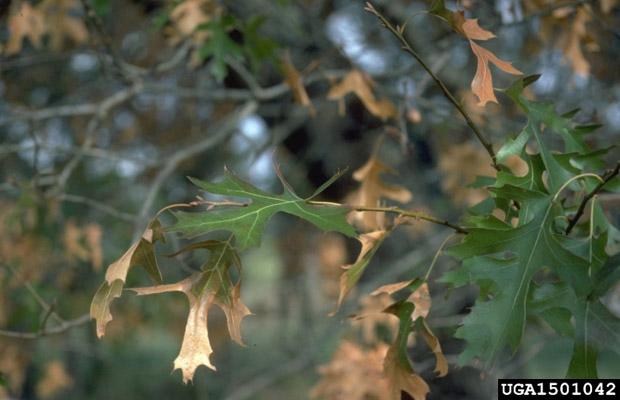Oak wilt is related to the fungus that causes Dutch elm disease (Ceratocystis ulmi) and clogs sapwood vessels in the oak trees, which inhibits water transport. This results in wilting and eventually kills the tree. Because the fungus has little genetic variation and rapidly kills its host, many scientists suspect the organism is not native to the United States.
Threat
It is likely that European white oaks, including the UK and Ireland’s native sessile (Q. petraea) and pedunculate or English oak (Q. robur), are also very susceptible to infection by the fungus and can be killed. It is therefore considered that it would pose a threat to oak trees and forests if it entered the UK.
Susceptible species
EPPO list 16 of the approximately 600 species of Quercus species as susceptible to damage by C. fagacearum infection, but 58 North American native oak species are known to be susceptible indicating a much wider host range. The most susceptible species are ‘red’ oaks, all of which are native to North America.
The UK’s native sessile and pedunculate oaks are ‘white’ oaks, but are also known to be susceptible to C. fagacearum, dying within one year of inoculation. Tree species in several other genera within the Fagaceae family have also been reported to be susceptible to C. fagacearum in artificial inoculations, including North American and European sweet chestnut (Castanea dentata and C. sativa respectively).
Spread
In the USA most trees can become infected by the fungus below ground. The fungus moves from an infected oak to a healthy oak via underground root contact. The disease can spread between root systems of trees growing as far as 50 feet apart.
Insects can spread oak wilt above ground. Above-ground spread occurs infrequently, but is the means by which new oak wilt infection centers can get started. The fungus creates sporulating mats between the bark and the wood when it invades oaks and sap-feeding beetles, are attracted to the sweet-smelling mats. The beetles feed on the mats and carry oak wilt spores to wounds on uninfected trees, continuing the spread of the disease. Spread can also occur as wood is transported.
Outbreak stage and national plans
A national contingency plan for oak wilt is available here.
Distribution
The pathogen is Present in 26 eastern and mid-western US states but is currently believed to be absent from Asia and Europe.
Symptoms
In the Red Oak family, the disease expresses itself in two primary ways. The first symptom is an oily green appearance in sections of the tree’s canopy, which rapidly turns a tan or red color. The second and less common expression is a heavy and rapid shedding of foliage with individual leaves displaying the symptoms previously mentioned. Infected Red Oaks typically die within a few months of infection.

Reporting suspect cases
If you think you have spotted the disease, please check our symptoms section before reporting it using TreeCheck or one of the Further Information contact points below.
Import & movement restrictions
The control of imports of oak timber into the EU, is specified under EU Plant Health Directive 2000/29/EC, and implemented in Great Britain by the Plant Health (Forestry) Order 2005. This order provides the ‘principal instrument for managing the import of trees, wood, wood products and bark’, and specifies ‘Oak (Quercus) originating in the USA’ as a commodity.
Further information
- https://www.na.fs.fed.us/spfo/pubs/fidls/oakwilt/oakwilt.htm
- https://www.nrcs.usda.gov/Internet/FSE_DOCUMENTS/nrcs144p2_002511.pdf
Questions and Answers
Contact:
Plant Health Inspection Branch
DAERA Northern Ireland
Tel: 0300 200 7847
Email: planthealth@daera-ni.gov.uk
